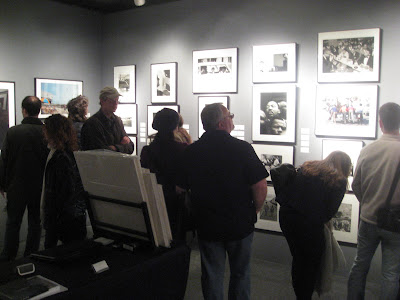Via Art Market News
April 6, 2012 By
Marion Maneker
Sotheby's NY
Christies NY
Phillips de Pury
$6.1m ; 193 out of 267 lots sold for 72% sell-through
SWANN Galleries
PRELIMINARY RESULTS OF SALE 2274, April 4 2012:
Sale total:
$1,202,122 with Buyer’s Premium
Hammer total:
$1,001,230
Estimates for sale as a whole: $1,245,350 – $1,834,950
We offered 435 lots; 304 sold (30% buy-in rate by lot)
Top lots, Prices with buyer’s premium:
6
William Eggleston, Untitled (from the series Los Alamos), dye-transfer print, 1970. $60,000 C
347*
Ansel Adams, Portfolio #4: What Majestic Word, In Memory of Russell Varian, with15 silver prints, 1963. $54,000 C
183* Camera Work Number 36, illustrated with 16 photogravures, signed & inscribed by Stieglitz, New York, 1911. $26,400 C
168** Portfolio with 90 photographs of a German dignitary’s travels to Asia and the Americas, silver prints, 1930s. $24,000 C
18
Weegee, Love Story & Ice Cream…Aspirin…Soda Pop…Vitamin Pills…Etc, maquette including two silver prints, with Weegee’s notations, circa 1940s. $20,400 D
292*
Margaret Bourke-White,
DC-4 Flying over New York City, silver print, 1939, printed circa 2000. $20,400 D
470*
Sebastiäo Salgado, Kuwait (oil fields), oversize silver print, 1991, printed 2000s. $19,200 C
187
Edward S. Curtis, Chief of the Desert, Navajo, orotone, 1904. $15,600 D
210
Ralph Steiner, Ten Photographs from the Twenties and Thirties & One From the Seventies portfolio, silver prints, 1920s-30s, 1970s, printed 1977. $15,600 C
419
Adams, Holy Cross Church, Santa Cruz, mural-sized silver print, 1960s. $14,400 C
417
Adams, triptych with three color studies: Rusted Metal, Leaves & Red Rock, offered with four color studies, all unique Polaroid SX-70 prints, 1972. $12,000 C
240
Imogen Cunningham, The Bath & Agave, two silver prints, 1925 & 1920, printed 1952-60s. $10,800 C
14
Helen Levitt, New York (boys playing over doorway), silver print, 1942, printed circa 1980. $10,800 C
385
Brett Weston, Guatemala Hills, silver print, 1968, printed 1970s. $10,200 C
4
Bruce Davidson, East 100th Street Facade, oversize silver print, 1966-68, printed 1980s-90s. $10,200 D
467
Salgado, Dinka Cattle Camp, Southern Sudan, oversize silver print, 2006, printed 2011. $10,200 C
39
Ellsworth Kelly, Grape Leaves II, lithograph, 1973-74. $10,200 C
174
Alfred Stieglitz, Picturesque Bits of New York and Other Studies, containing 9 of 12 photogravures, 1894-97, printed 1897. $9,600 D
345
Adams, Lichens and Rock, silver print from a Polaroid Type 55 negative, 1962, printed 1962-63. $9,600 C
3
Henri Cartier-Bresson, Swan Lake, Bolshoi Theatre, Moscow, silver print, 1954, printed 1980s. $9,000 D





